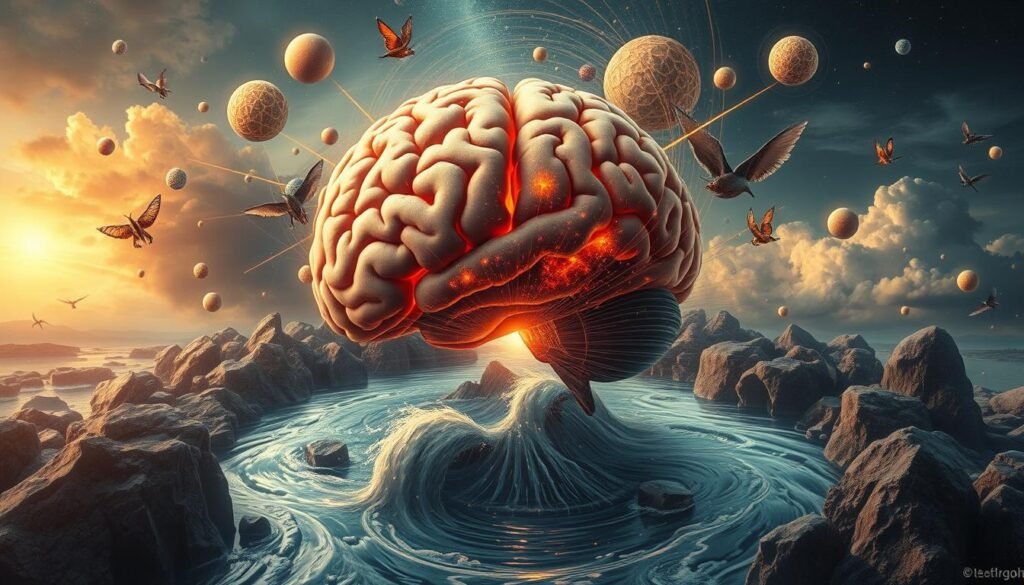In our time, caring for mental health gets a lot of attention. The Body Keeps The Score by Bessel van der Kolk is key for understanding trauma’s big effect. It helps those healing from trauma learn how it affects both mind and body, changing one’s health.
The book talks about tough facts, like half a million U.S. women raped each year. Also, one in five Americans were molested. Van der Kolk connects trauma with lasting health issues. He’s studied this for over 30 years. He shows trauma is both a body and mind issue.
Key Takeaways
- Over 500,000 children are reported for abuse and neglect each year in the U.S.
- One out of four Americans reports having been left with bruises after being hit as a child.
- The Centers for Disease Control and Prevention identify childhood trauma as the single largest public health issue in the U.S.
- Traumatized individuals show significant deficits in filtering relevant from irrelevant information.
- Dr. van der Kolk has accumulated over three decades of research and clinical studies focused on trauma and its impact.
- The holistic approach to trauma treatment in the book includes therapy methods like EMDR, yoga, and mindfulness.
- The Body Keeps The Score has been published in 36 languages and spent nearly 300 weeks on the New York Times Bestseller list.
Introduction to ‘The Body Keeps The Score’
Welcome to a look into The Body Keeps The Score. This book is by Dr. Bessel van der Kolk. It talks deeply about how trauma affects people. This important book has been a top seller for a long time. Since its release in 2014, many people have bought it. In 2021, it was #1 for more than six months.

Dr. van der Kolk is an expert on how trauma affects the brain and body. His work started with war veterans. Now, it includes how childhood trauma hurts us too. He shares shocking facts. For example, many Americans faced tough situations as kids, he says.
The costs of child trauma are huge, even more than cancer or heart disease. It’s not just in our heads. It affects our bodies too, causing many illnesses. Dr. van der Kolk’s work shows why it’s key to understand these effects. This helps in healing from trauma.
Dr. van der Kolk gives us important information. He shows how trauma changes our brain and body. His insights help in improving mental health and recovery. Knowing all this is essential. It helps in dealing with trauma’s effects in the long term.
Claim Your FREE Copy of “The Body Keeps The Score” Here.
The Impact of Trauma on the Brain and Body
Trauma deeply affects our brain and body, leading to big changes. One main effect is that our amygdala, the part of the brain that handles emotions, can get overwhelmed. This makes it hard to control how we feel. People with PTSD see their stress hormones shoot up by 30% when faced with triggers.

Long-lasting trauma can show up in our bodies as muscle spasms, back pain, migraines, and fibromyalgia. Our brains often stay in fight-or-flight mode, which is meant to protect us but can make things worse over time. It can mess with our memory, focus, and how we see safety, changing how we connect with others.
There’s still hope because of neuroplasticity, which lets our brain change and heal. Treatments like therapy, yoga, and meditation can cut PTSD symptoms by half. These methods help lower stress levels, boost immune function, decrease blood pressure, and make us feel better overall.
Trauma also affects how we interact with others, leading to anxiety, anger, and trust issues. About 60% of people with PTSD see changes in their personality. This makes it hard to connect with others. Getting support from friends and going through therapy can really help heal.
“Trauma is a pressing public health issue that demands immediate attention,” says Dr. Bessel van der Kolk in “The Body Keeps the Score.” This book, which has been a New York Times best-seller for nearly three years and sold almost two million copies worldwide, shows how crucial it is to understand and tackle trauma.
“The neuroscience behind trauma is a vital field of study that can lead to more effective treatments and a deeper understanding of how humans adapt and heal,” said Dr. Van der Kolk.
Healing from Trauma: Effective Therapy Techniques
Healing from trauma is a journey that’s different for everyone. The book “The Body Keeps The Score” uses over thirty years of research. It shows lots of therapy methods for dealing with trauma. It mixes old and new therapy ways together.
EMDR is a key treatment talked about. It’s good for all types of trauma. It helps people process their trauma memories, changing how they feel and react.
“Through mindfulness and body-oriented approaches, trauma survivors can regain a sense of control and safety.”
Mindfulness is also really important. It helps folks stay in the moment and understand their bodies. This reduces stress and anxiety that come with trauma. It’s key for managing feelings.
The book also talks about somatic experiencing. It’s about noticing our bodies to fight feeling disconnected. This method lets people let go of tension and stress in a healthy way.
Adding things like neurofeedback and yoga helps too. Neurofeedback trains the brain to control itself better. Yoga helps people feel connected to their bodies again. These methods are good for trauma healing.
Research from the Netherlands is also shared. It shows how trauma can change how the brain works. This helps make therapy better because it targets those brain changes.
Real stories, like the Chowchilla kidnapping, show how trauma affects people over time. These stories, along with research, give a full picture of trauma and healing.
Innovative therapy methods, like those in “The Body Keeps The Score,” are changing how we treat trauma. They bring hope and healing to many people.
Claim Your FREE Copy of “The Body Keeps The Score” Here.
‘The Body Keeps The Score’ in Depth: Chapter Summaries
“The Body Keeps the Score” explores trauma deeply. It starts with the first four chapters. These chapters help us understand and start healing from trauma.
Chapter 1: The Rediscovery of Trauma talks about trauma’s effects. It looks back to the late 19th century. The chapter shows how childhood trauma affects people more than adult trauma.
In The Body’s Alarm System, the book talks about how trauma changes the brain. It makes stress hormones increase, affecting our bodies. Vietnam veterans show us how trauma can affect emotions and relationships.
Chapter 3: The Imprint of Trauma explores trauma’s lasting effect on the brain. Brain studies from the 1990s are discussed. They show how trauma affects our emotions and speech, changing how we see time and reality.
Chapter 4: The Treatment and Recovery Process brings us hope. It talks about treatments like EMDR, yoga, and Internal Family Systems (IFS). It explains why drugs like Prozac don’t always help. But, with the right help and support, getting better is possible.
The book’s first chapters are very important. They show us how big of an issue trauma is. But, they also tell us that healing is possible with the right methods.
Conclusion
“The Body Keeps The Score” shows us how crucial it is to understand trauma. Bessel van der Kolk tells us that healing from trauma is a journey we should take together. Looking into how trauma affects health shows us that bad childhood experiences and PTSD can cause many health problems.
Many Americans have suffered from childhood trauma. This has long-term effects on their health, including mental health issues. Dr. van der Kolk suggests new ways to heal, like mindfulness and neurofeedback. These methods help people become more resilient.
Trauma can deeply affect a person’s well-being, but it’s possible to overcome. Support from others and good therapy are key. Bessel van der Kolk’s book gives hope to many people on their path to recovery. It has been a best-seller, showing its influence and importance.

